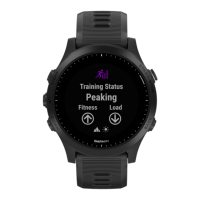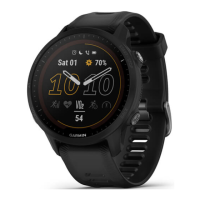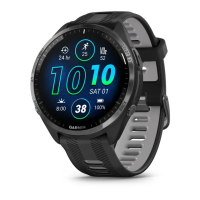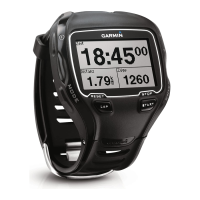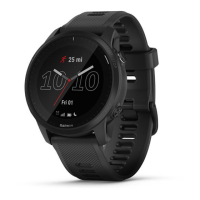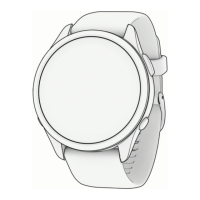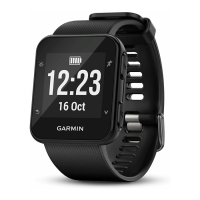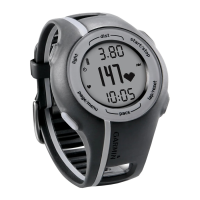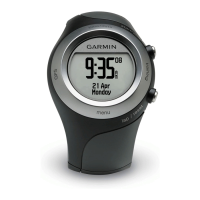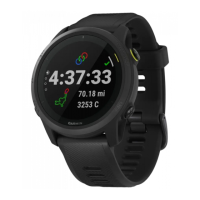4
Stop your activity, and save it.
Based on the recorded data, the foot pod calibration value
changes, if necessary. You should not need to calibrate the
foot pod again unless your running style changes.
Calibrating Your Foot Pod Manually
Before you can calibrate your device, you must pair your device
with the foot pod sensor (Pairing ANT+ Sensors, page 22).
Manual calibration is recommended if you know your calibration
factor. If you have calibrated a foot pod with another Garmin
product, you may know your calibration factor.
1
From the watch face, hold .
2
Select Settings > Sensors and Accessories.
3
Select your foot pod.
4
Select Cal. Factor > Set Value.
5
Adjust the calibration factor:
• Increase the calibration factor if your distance is too low.
• Decrease the calibration factor if your distance is too high.
Setting Foot Pod Speed and Distance
Before you can customize the foot pod speed and distance, you
must pair your device with the foot pod sensor (Pairing ANT+
Sensors, page 22).
You can set your device to calculate speed and distance using
your foot pod data instead of GPS data.
1
From the watch face, hold .
2
Select Settings > Sensors and Accessories.
3
Select your foot pod.
4
Select Speed or Distance.
5
Select an option:
• Select Indoor when you are training with GPS turned off,
usually indoors.
• Select Always to use your foot pod data regardless of the
GPS setting.
Using an Optional Bike Speed or Cadence
Sensor
You can use a compatible bike speed or cadence sensor to
send data to your device.
• Pair the sensor with your device (Pairing ANT+ Sensors,
page 22).
• Set your wheel size (Wheel Size and Circumference,
page 35).
• Go for a ride (Starting an Activity, page 1).
Training with Power Meters
• Go to www.garmin.com/intosports for a list of ANT+ sensors
that are compatible with your device (such as Vector
™
).
• For more information, see the owner's manual for your power
meter.
• Adjust your power zones to match your goals and abilities
(Setting Your Power Zones, page 7).
• Use range alerts to be notified when you reach a specified
power zone (Setting an Alert, page 24).
• Customize the power data fields (Customizing the Data
Screens, page 24).
Using Electronic Shifters
Before you can use compatible electronic shifters, such as
Shimano
®
Di2
™
shifters, you must pair them with your device
(Pairing ANT+ Sensors, page 22). You can customize the
optional data fields (Customizing the Data Screens, page 24).
The Forerunner device displays current adjustment values when
the sensor is in adjustment mode.
Situational Awareness
Your Forerunner device can be used with the Varia Vision
™
device, Varia
™
smart bike lights, and rearview radar to improve
situational awareness. See the owner's manual for your Varia
device for more information.
NOTE: You may need to update the Forerunner software before
pairing Varia devices (Updating the Software Using Garmin
Express, page 31).
tempe
The tempe is an ANT+ wireless temperature sensor. You can
attach the sensor to a secure strap or loop where it is exposed
to ambient air, and therefore, provides a consistent source of
accurate temperature data. You must pair the tempe with your
device to display temperature data from the tempe.
Customizing Your Device
Customizing Your Activity List
1
From the watch face, hold .
2
Select Settings > Activities & Apps.
3
Select an option:
• Select an activity to customize the settings, set the activity
as a favorite, change the order of appearance, and more.
• Select Add Apps to add more activities or create custom
activities.
Customizing the Widget Loop
You can change the order of widgets in the widget loop, remove
widgets, and add new widgets.
1
From the watch face, hold .
2
Select Settings > Widgets.
3
Select a widget.
4
Select an option:
• Select Reorder to change the location of the widget in the
widget loop.
• Select Remove to remove the widget from the widget
loop.
5
Select Add Widgets.
6
Select a widget.
The widget is added to the widget loop.
Activity Settings
These settings allow you to customize each preloaded activity
app based on your needs. For example, you can customize data
pages and enable alerts and training features. Not all settings
are available for all activity types.
Hold , select Settings > Activities & Apps, select an activity,
and select the activity settings.
3D Distance: Calculates your distance traveled using your
elevation change and your horizontal movement over ground.
3D Speed: Calculates your speed using your elevation change
and your horizontal movement over ground (3D Speed and
Distance, page 25).
Accent Color: Sets the accent color of each activity to help
identify which activity is active.
Alerts: Sets the training or navigation alerts for the activity.
Auto Climb: Enables the device to detect elevation changes
automatically using the built-in altimeter.
Customizing Your Device 23
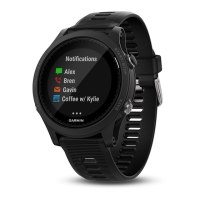
